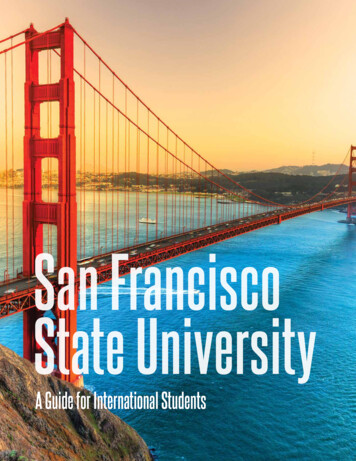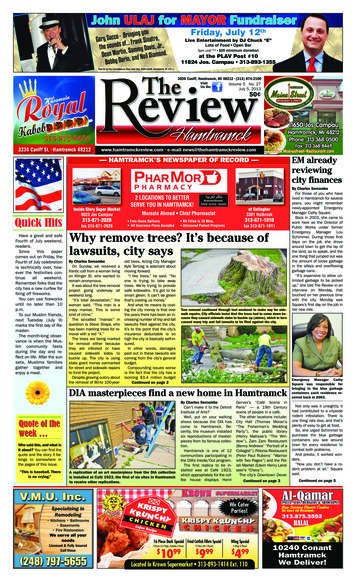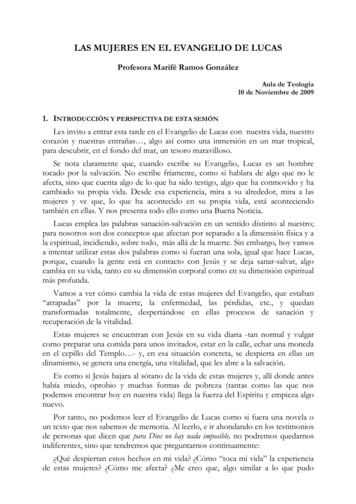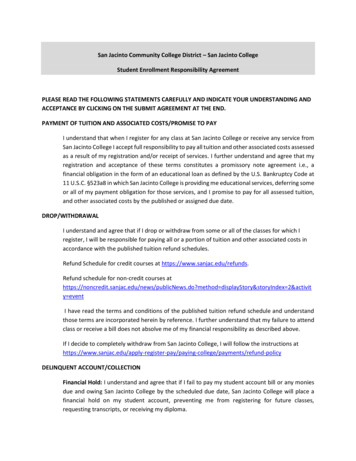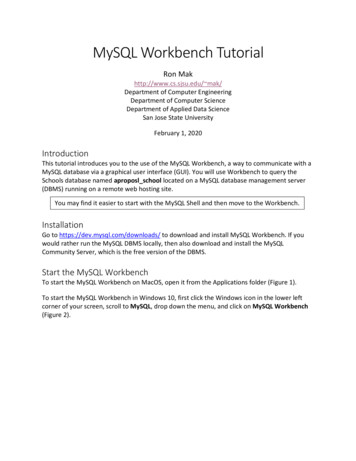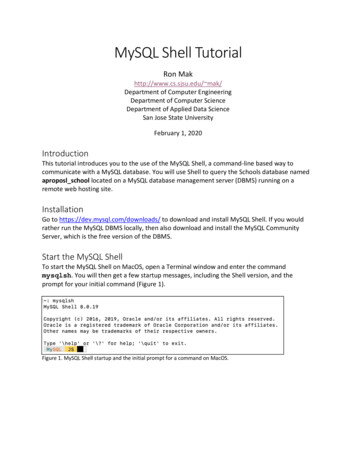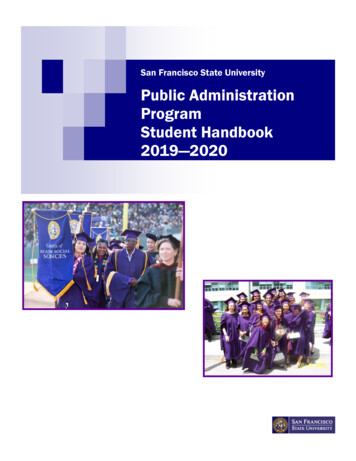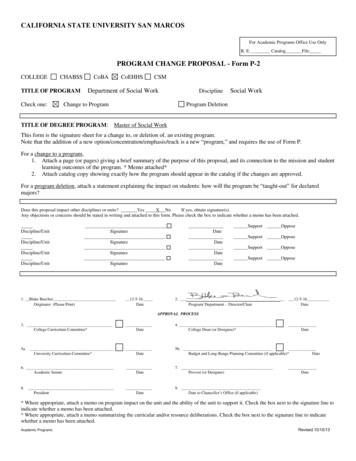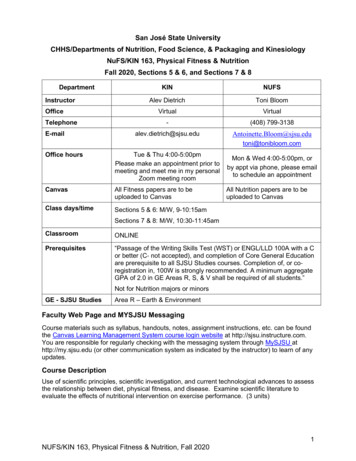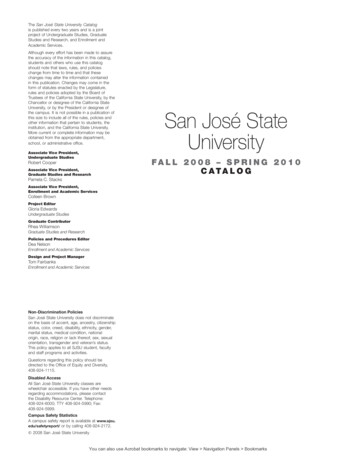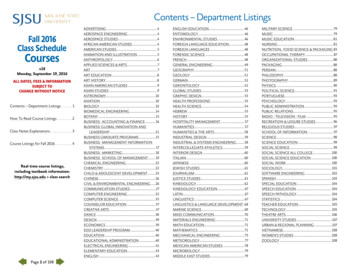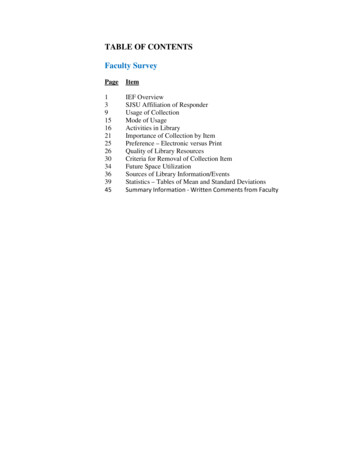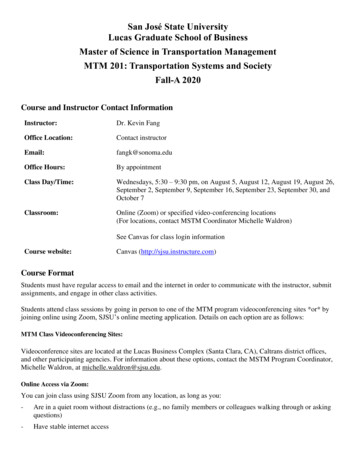
Transcription
San José State UniversityLucas Graduate School of BusinessMaster of Science in Transportation ManagementMTM 201: Transportation Systems and SocietyFall-A 2020Course and Instructor Contact InformationInstructor:Dr. Kevin FangOffice Location:Contact instructorEmail:fangk@sonoma.eduOffice Hours:By appointmentClass Day/Time:Wednesdays, 5:30 – 9:30 pm, on August 5, August 12, August 19, August 26,September 2, September 9, September 16, September 23, September 30, andOctober 7Classroom:Online (Zoom) or specified video-conferencing locations(For locations, contact MSTM Coordinator Michelle Waldron)See Canvas for class login informationCourse website:Canvas (http://sjsu.instructure.com)Course FormatStudents must have regular access to email and the internet in order to communicate with the instructor, submitassignments, and engage in other class activities.Students attend class sessions by going in person to one of the MTM program videoconferencing sites *or* byjoining online using Zoom, SJSU’s online meeting application. Details on each option are as follows:MTM Class Videoconferencing Sites:Videoconference sites are located at the Lucas Business Complex (Santa Clara, CA), Caltrans district offices,and other participating agencies. For information about these options, contact the MSTM Program Coordinator,Michelle Waldron, at michelle.waldron@sjsu.edu.Online Access via Zoom:You can join class using SJSU Zoom from any location, as long as you:-Are in a quiet room without distractions (e.g., no family members or colleagues walking through or askingquestions)-Have stable internet access
-Use a video camera and good quality microphone so that you are seen as well as heard-Follow good "meeting etiquette" principles (one such list: g-etiquette-every-professional-know/)To access class sessions by Zoom, click on the following link from your computer ortablet: t9IWJMhOwAvQDq/ics?icsToken 98tyKuCtrT4jEtKdsB6BRowMA4 4Xfzwplxfgqd3sRioWglJahevH9VoH7pQB nGPlan to join at least ten minutes before 5:30 pm, to make sure you are ready when class begins. (The very firsttime you join from a computer or device, allow extra time for set-up.)The university has many useful tutorials on how to use Zoom here: ex.htmlCourse DescriptionCore transportation knowledge and systems thinking. Characteristics of travel modes and infrastructuralelements that produce transportation systems; public, private, and nonprofit actors involved in transportation;transportation systems as levers toward achieving economic vitality, social equity, environmental sustainability,and community goals; and key challenges transportation system managers will face in the coming decade. Note:this course satisfies the GWAR for the MSTM program.Lucas College and Graduate School of Business Program Learning Goals(Note: Not all program learning goals are covered in every course)Goal 1: Business Knowledge: Understand basic business principles and demonstrate disciplinespecific competencies as applied to local and global environments.Goal 2: Communication: Communicate ideas clearly, logically, and persuasively in oral and writtenformat, using technology appropriately.Goal 3: Ethical Awareness: Recognize, analyze, and articulate solutions to ethical issues that arise inbusiness.Goal 4: Leadership, Teams and Diversity: Comprehend the challenges and opportunities of leadingand working in diverse teams and environments.Goal 5: Critical Thinking: Comprehend, analyze, and critically evaluate complex and unstructuredqualitative and quantitative business problems, using appropriate tools and technology.Goal 6: Innovation: Recognize, analyze, and articulate strategies for promoting creativity andinnovation.MSTM Program Learning Goals:(Note: Not all program learning goals are covered in every course)Goal 1: Transportation Systems and Society: Develop a systems-savvy and global perspective on solvingtransportation management challenges
Goal 2: Transportation Policy: Develop solutions to transportation management challenges that integrateknowledge of the transportation policy environmentGoal 3:Leadership: Identify and analyze leadership styles and traitsGoal 4: Communications: Communicate effectively with a diverse workforce and citizenryGoal 5: Analytical skills: Identify and evaluate transportation management issues using appropriate data andmethodsCourse Learning OutcomesUpon successful completion of this course, students will be able to:1. Describe the primary modes of transportation and their functions, current levelsof use, and likely levels of use in the future2. Explain how “the transportation system” functions as interacting systems ofinfrastructure, services, and travel modes3. Explain how transportation system performance is influenced by natural andman-made environments4. Explain how transportation systems serve as tools to achieve fundamental socialgoals such as equity, economic vitality, and environmental health5. Describe the roles of the many actors in the “transportation ecosystem,” includingpublic agencies from the local to federal and international levels, private sectorsfirms providing transportation services and infrastructure, and individual travelersand shippers6. Describe the key challenges facing transportation managers in the comingdecade, including automated/connected, shared, and electric vehicles, andmanagement strategies to respond to this new world7. Describe the importance of innovation in technology and in organizationalmanagement practices in the transportation sector8. Use library and online resources to identify relevant professional and scholarlyliterature on transportation topicsRequired Texts/ReadingsFree e-textbookWe will utilize the following text:Jeffrey Tumlin. Sustainable Transportation Planning: Tools for Creating Vibrant, Healthy, and ResilientCommunities. Hoboken, NJ: John Wiley and Sons, 2012.This is available as a free e-book through the SJSU library website. If you’d like to purchase a hard copy of thetext, used copies start at around 30.Writing HandbookStudents must purchase one required text:Kate L. Turabian. A Manual for Writers of Research Papers, Theses, and Dissertations. 9th ed. Chicago:
University of Chicago Press, 2018.New copies can be purchased for about 15.Article ReadingsAdditional readings will be posted as links (see Course Schedule below or Canvas) or posted to the Files sectionof the course Canvas site.Library LiaisonThe Library Liaison for the Lucas Graduate School of Business is Christa Bailey (christa.bailey@sjsu.edu).Course Requirements and AssignmentsThis course is taught as a seminar. Students are expected to engage with the course material and participate inclass discussions. Please be respectful of your classmates during class and be aware of what is captured by yourcamera and microphone. Students course grades will be based on the sum of the following assignments:Term PaperThe major assignment for the class is a term paper on a transportation management issue. Students will explorewhat scholarly research tells us about a transportation problem and potential solutions to that problem. Studentswill complete this assignment in three steps: a short sketch of the paper and two drafts. After the sketch and firstdraft, students will receive feedback from the instructor or their peers. Detailed instructions for each portion ofthe assignment will be shared on Canvas and discussed in class.Term Papers should be about 3,000 words, exclusive of the bibliography and any appendices.MTM 201 is a 3-unit course that satisfies the Graduation Writing Assessment Requirement (GWAR). To satisfythe GWAR requirement, students must receive at least a “C” grade on the final draft of the term paper. Studentswho receive a grade below “C” for this part of the course will not meet the GWAR requirement, even if theiroverall grade for the course is higher. Please check with the instructor or MSTM Program Director if you areunclear about these requirements.Streets of the Future Assignment and Travel Behavior InterviewsEarly in the semester will be two small assignments where students will do some pre-class search to setup inclass discussions. In the first assignment, students will look at examples of streets around the world and overtime and explore the role of streets in society. In the second assignment, students will conduct two informalinterviews to explore individual decision-making in transportation.Transportation News PresentationsStudents will bring in interesting examples from transportation current events in the form of short presentations.Several of these will occur each week in the second half of the course.Final ExamStudents will complete a final exam on the last day of class which will evaluate student’s comprehension of thematerial covered over the whole session.
Grading InformationThe course assignments will be weighted as follows:TaskTerm Paper – Sketch/Peer Review% of Course GradeLearning ObjectivesAddressed3%2, 3, 4, 5, 8Term Paper – First Draft6%2, 3, 4, 5, 8Term Paper – Second Draft35%2, 3, 4, 5, 8Streets of the World Assignment6%1, 2, 3, 4, 8Travel Behavior Interview Assignment6%1, 3, 4, 5Transportation News Presentations9%2, 3, 4, 5, 6, 7Final exam35%1, 2, 3, 4, 5, 6, 7Determination of GradesLetter grades for the course will assigned based on the cumulative total of points earned on assignments and thefinal exam according to the following table:Final grade determinationPercentage93.33% and above93.33% to 89.5%89.5% to 86.67%86.67% to 83.33%83.33% to 79.5%79.5% to 76.66%76.66% to 73.33%733.33% to 69.5%69.5% to 66.66%66.66% to 63.33%63.33% to 59.5%below 59.5%GradeAAB BBC CCD DDFLate papersLate papers will are accepted with a 10% deduction once late, plus an additional 5% deduction per additionalbusiness day an assignment is late, with a maximum deduction of 40%.
University PoliciesPer University Policy S16-9 (http://www.sjsu.edu/senate/docs/S16-9.pdf), information relevant to all courses,such as academic integrity, accommodations, dropping and adding, consent for recording of class, etc. isavailable on Office of Graduate and Undergraduate Programs’ Syllabus Information web page athttp://www.sjsu.edu/gup/syllabusinfo/.” Make sure to visit this page, review, and be familiar with theseuniversity policies and resources.Course ScheduleNote: This schedule is subject to change with fair notice. Changes will be noted in class and via email.Assignment Due DatesStreets of the World assignmentWednesday, August 12 (by the start of class)Travel Behavior assignmentWednesday, August 26 (by the start of class)Transportation News PresentationsMultiple dates. Presentation slots each class between Week 5 and Week 10.Term PaperSketch (1-2 pages): Wednesday, September 2 (by the start of class)First draft: Sunday, September 13 (by 11:59pm)Second draft: Friday, October 9 (by 11:59pm)Final ExamWednesday, October 7 (during class)Class 1 – Wednesday, August 5IntroductionsTransportation BasicsKey societal trendsReadings Tumlin (2012) – Sustainable Transportation PlanningChapter 1: IntroductionChapter 2: Sustainable Transportation (Pages 7-14)
Class 2 – Wednesday, August 12GWAR Assignment, Part 1: Introduction to the assignmentTransportation-Land Use ConnectionDiscussion: Streets of the world Tumlin (2012) – Sustainable Transportation PlanningChapter 5: StreetsBryan Morris, “From Horse Power to Horsepower,” Access Magazine, Spring eid Ewing and Robert Cervero. "Travel and the built environment: A meta-analysis." Journal of theAmerican planning association 76, no. 3 (2010): 265-294.Class 3 – Wednesday, August 19Travel Behavior and TrendsGWAR Assignment, Part 2: Finding and Accessing Library ResourcesTransportation Externalities: Natural environment Tumlin (2012) – Sustainable Transportation PlanningChapter 2: Sustainable Transportation (Pages 15-22)Chapter 3: Transportation and Public HealthGiovanni Circella, Kate Tiedeman, Susan Handy, Farzad Alemi, and Patrica Mokhtarian. “What AffectsU.S. Passenger Travel? Current Trends and Future Perspectives.” Davis, CA: National Center forSustainable Transportation, 2016. https://escholarship.org/uc/item/2w16b8bf (Pages 1-28)For reference US Department of Transportation - Bureau of Transportation Statistics, “Pocket Guide ToTransportation,” January 2019. ansportation/224731/pocket-guide-2019.pdf or s/menu/dropdown.htmlClass 4 – Wednesday, August 26GWAR Assignment, Part 3: CitationsTransportation Externalities: SafetyDiscussion: Travel behavior interviews Emma Fitzsimmons, “More Pedestrians and Cyclists are Dying in N.Y.C. Drivers are Often to Blame.March 15, 2020.Alissa Walker, “Oslo saw zero pedestrian and cyclist deaths in 2019. Here’s how the city did it,”Curbed, January 3, 2020. on-zero-pedestriancyclist-deaths
Class 5 – Wednesday, September 2GWAR Assignment, Part 4: Peer Review ActivityCongestionTransportation Externalities: Road Building Tumlin (2012) – Sustainable Transportation PlanningChapter 9: Motor VehiclesChapter 10: ParkingTransportation For America, “The Congestion Con,” 2020. gestion-Report-2020-FINAL.pdfSusan Handy and Marlon Boarnet, “Impact of Highway Capacity and Induced Travel on PassengerVehicle Use and Greenhouse Gas Emissions.” Sacramento, CA: California Air Resources Board, apacity/highway capacity brief.pdfDavid Phillips, “Hiring Managers Biased Against People Who Live Farther Away,” Harvard BusinessReview, December 10, 2018, el Manville, “Longer View: The Fairness of Congestion Pricing,” Transfers Magazine, Spring2019. ness-of-congestion-pricing/Class 6 – Wednesday, September 9Transit Tumlin (2012) – Sustainable Transportation PlanningChapter 8: TransitJarrett Walker, “Does Elon Musk understand urban geometry?,” July 21, esnt-understand-geometry.html.Class 7 – Wednesday, September 16Active Transportation Tumlin (2012) – Sustainable Transportation PlanningChapter 6: PedestriansChapter 7: BicyclistsAlta Planning and Design, “Understanding the “Four Types of Cyclists,” August 10, he-four-types-of-cyclists-112e1d2e9a1bClass 8 – Wednesday, September 23Transportation Revolutions, Electric VehicleMore on Transit
Class 9 – Wednesday, September 30Transportation Revolutions, Part 2: Ridehailing and Autonomous Vehicles Regina Clewlow, “Disruptive Transportation: The Adoption, Utilization, and Impacts of Ride-Hailing inthe United States,” Transfers Magazine, Spring 2019, tion-ride-hailing/.Bloomberg Philanthropies/Aspen Institute. “Taming the Autonomous Vehicle: A Primer for Cities.”2017. theAutonomousVehicleSpreadsPDF.pdfTumlin (2012) – Sustainable Transportation PlanningChapter 4: The City of the FutureClass 10 – Wednesday, October 7Final ExamTBACourse wrap-up discussion
goals such as equity, economic vitality, and environmental health 5. Describe the roles of the many actors in the “transportation ecosystem,” including public agencies from the local to federal and international levels, private sectors firms providing transportation services and
